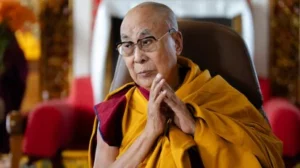GS 1-History and Culture

Context:
Recent debates have intensified regarding the selection of the next Dalai Lama. The primary issue revolves around whether the Dalai Lama has the sole authority to choose his successor or if China has a role in this process.
Reincarnation in Buddhism
- Concept of Reincarnation: In Buddhist belief, consciousness persists beyond death, leading to rebirth into a new existence.
- Samsara: This refers to the continuous cycle of birth, death, and rebirth.
Mechanism of Reincarnation in Buddhism
- Karma: A person’s past deeds influence the form in which they are reborn. Positive actions result in favorable rebirths, while negative ones lead to less desirable existences.
- Realms of Rebirth: One may be reborn in various realms, including divine beings, demi-gods, humans, animals, ghosts, or infernal beings.
- Liberation: Following the Noble Eightfold Path enables one to attain Nirvana, breaking free from the cycle of rebirth.
Avalokiteshvara – The Bodhisattva of Compassion
- Avalokiteshvara is a highly venerated bodhisattva, especially within Mahayana Buddhism, embodying infinite compassion.
- Historically, the term “bodhisattva” was used to describe the Buddha, Gautama Siddhartha, in his previous incarnations.
- Avalokiteshvara symbolizes the ultimate commitment of a bodhisattva—to delay achieving Buddhahood to guide all beings toward liberation from suffering.
The Dalai Lama and His Institution
- Dalai Lama as Avalokiteshvara’s Manifestation: In Tibetan Buddhism, the Dalai Lama is considered an incarnation of Avalokiteshvara, making him a key religious and national figure in Tibet.
- Origins of the Dalai Lama Lineage: The institution was formally established in the 15th century when Gedun Gyatso was recognized as the reincarnation of Gedun Drub. Since then, successive reincarnations have been identified.
- Political and Religious Authority: From the time of the 5th Dalai Lama, Ngawang Lobsang Gyatso (1642), the Dalai Lamas functioned as both spiritual and political leaders of Tibet until 2011, when their political role was abolished.
- Nobel Laureate: The 14th Dalai Lama, Tenzin Gyatso, was awarded the Nobel Peace Prize in 1989.
The Future of the Dalai Lama Institution
- The Dalai Lama has repeatedly emphasized that the decision regarding whether the institution should continue rests solely with the Tibetan people.
- Tibetan religious and political organizations, such as the 14th Tibetan Religious Conference, have asserted that the legitimacy of a future Dalai Lama can only be determined based on Tibetan Buddhist traditions and the Dalai Lama’s own wishes.
- Tibetans have strongly opposed any Dalai Lama appointed by China.
- The Dalai Lama has also maintained that if the Tibetan issue remains unresolved during his lifetime, his reincarnation would take place in a free country.
China’s Stance and Geopolitical Implications
- China insists that the selection of the Dalai Lama must align with historical precedents and Chinese regulations.
- Beijing asserts control over the process, similar to how it appointed the Panchen Lama, a move widely rejected by Tibetans.
- Many Tibetans and international observers view China’s stance as an attempt to exert control over Tibetan Buddhism and strengthen its authority over Tibet.
Impact on India and Global Relations
- India, which hosts both the Dalai Lama and the Tibetan government-in-exile, plays a crucial role in this matter.
- While India officially adheres to the One China Policy, it also acknowledges the importance of Tibetan cultural and religious independence.




